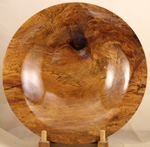|
|
Glass
Latest update: 2020/04/07
As one of my artistic endeavors, I work in glass, primarily using a small torch with soft glass like
effetre/moretti COE (Coefficient Of Expansion) 104, though occasionally work with Borosilicate (Boro) COE 33.
I'll explain more about glass terms in other instructional pages as time permits.
My history with Glass:
I began with kiln work after learning ceramics on a kick wheel, then slipcasting and other ceramic arts.
This provided a basis for understanding the operation of an electrically fired kiln, though most ceramic kilns
of the time only had rough temperature controls using a "cone" scale to determine the firing temperature.
While interesting, it seemed somewhat limited for what I wanted to create, but was helpful in
providig an understanding of glazes and firing schedules.
While in the Army, I was exposed to "hot glass" using a large furnace and glory hole in an Army Craft Shop.
There I learned how to handle hot glass and blow relatively simple objects.
I successfully created plates and platters, a paperweight or two and a few wine
goblets before I rotated out to another Army base.
One particualarly famous hot glass artist that provides me encouragement is Dale Chihuly.
His work shown at the glass museum in Tacoma and an installation in the
Seattle center is incredible.
Years later, I took a class in Shelton, Washington, which primarily focused on fusing and
slumping, with some Pâte de Verre work. Pâte de Verre essentially means "paste of glass"
and is a kiln casting technique that involves placing glass frit (crushed or powdered glass)
into molds and firing it to produce an item. While interesting, I was more intrigued with the
making of the molds than the actual firing process.
Around the same time, I was exposed to lampworking and created my first beads. Beads are usually
made from soft glass and involve "winding" hot glass from a rod onto a bead release coated mandrel.
The hole through the bead is determined by the diameter of the mandrel and the amount of bead release
built up on it. A mandrel is little more than a stainless steel rod of a given size, usually from
1/16" to 1/8" and about 10" to 12" long. without the bead release, the glass would adhere to the
mandrel and be impossible to remove intact.
Making a bead seems to be a simple process, and conceptially, it is. You just heat up the mandrel a bit,
and melt glass onto it with one hand as you rotate the mandrel with the other hand. However, in practice
it is a juggling match between the temperature of the bead you're creating, temperature of other glass
you are adding, and various techniques to get the bead to the shape you want. It's not too difficult
to learn the basic processes, but can take years of practice to get really good at it (like many art medium).
I've since also started using Borosilicate (Boro) glass, COE 33.
My Current Art
In soft glass, I typically produce beads and marbles, though I also make various other items
suitable for jewelry and the like with various kiln fusing and slumping techniques.
I also produce some marbles in Borosilicate glass (COE 33), though am limited to rather small
ones due to insufficient oxygen for the higher heat Boro glass needs. Differences between types of
glass will be discussed in the instructional materials to be provided later. Suffice to say, you
don't want to mix glasses with different expansion rates or the resultant art will self-destruct with
temperature changes.
Equipment in my glass studio
Supplies are costly here in Hawaii, primarily due to additional shipping costs compared to the
mainland of the United States. In particular, gasses used for the torch and electricity to run the
kiln are considerably higher cost than even the West Coast. For example, Propane runs around $5.00 per gallon
while oxygen is astronomical compared to most mainland locations. A recent 125 cubic foot tank was
over $128.00, and abbout 4 times the cost of oxygen in most areas of California.
Electricity costs nearly $0.42 per Kilowatt Hour (KWH), which is over twice as high as even the highest locations
on the mainland. Most folks pay from $0.12 to $0.18 per KWH.
Glass rods, plate and frit often cost as much to ship here as the purchase price, which makes one
want to conserve all supplies whenever possible. These costs directly impact my ability to sell
my work reasonable prices.
I currently have two torches, both of which have low gas consumption. Primary torch is a Nortel
Minor burner, and my alternate torch is a Devardi Spartan torch.
Both run from bottled Propane and a 5 LPM (Liter Per Minute) concentrator. Even with the high cost
of electricity, it is much less expensive than bottled oxygen. My current kiln is a Fusebox II
desighed for beadwork, with a Partlow 3167 pocess controller for temperature control. THe front
opening doors allow moving beads (on mandrels) and marbles into the kiln without losing much heat,
and it is well enough insulated to allow a slow ramp down after annealing.
Please bear with me as I fully populate this page. If you have any suggestions, please email me
or fill out a contact form.
Coming Soon:
-- pictures of available glass items for sale
--pictures of other examples of my glass working
-- instructional pages on various parts of glass working art.
|
|
| |
| |
|
|


